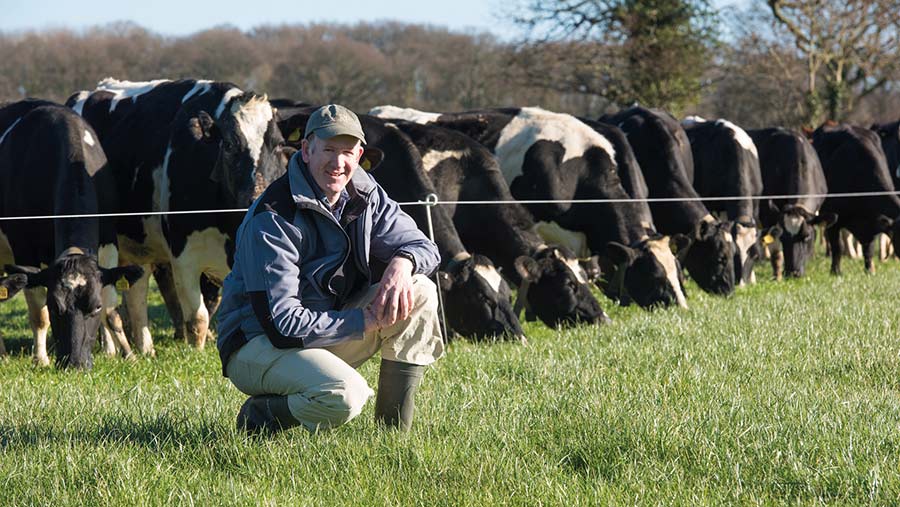How a farmer is using minimal antibiotics in his dairy herd
 © John Eveson
© John Eveson Tim Downes has been farming with minimal antibiotics for the past six years at his two dairy farms in Shrewsbury, Shropshire.
Having been in organic production for 20 years, Mr Downes, who farms alongside his wife Louise and his parents John and Chris, has refined the system to suit this new market.
After seeing demand grow for reducing antibiotics, in 2014 Mr Downes decided it was a market he wanted to pursue.
See also: How to dry off cows to treat mastitis successfully
Then they were treating around 10% of their 200-cow herd with an antibiotic dry cow tube at drying off because they had a cell count of more than 250,000. Now Mr Downes has only treated two cows with antibiotics in the past year.
Farm Facts
- Converted to organic in 1998
- Spring block calving
- 480 Irish Friesian, Norwegian Red, Fleckvieh and New Zealand Friesian cows across two herds
- Finishing Aberdeen Angus beef cattle for Waitrose
- 450ha over six farms
- Producing without antibiotics for Omsco
- Tim and Louise, his parents John and Chris, a herdsman Shaun, two assistants Taylor and Peter, at the home farm
- 24/48 herringbone at the home farm, 18/18 Fullwood at Webscott
The key is to put systems in place that reduce the risk of infections, alongside good stockmanship, he believes.
Mr Downes first sought the advice of others who were already producing milk without antibiotics, and researched how to manage the system.
Breeding
To raise the cows’ resilience he steered away from high-yielding, high-maintenance animals, towards crossbreds – specifically Norwegian Reds.
“We started using Norwegian Reds as Norway uses fewer antibiotics, so they are actively breeding for health traits.”
When choosing breeding animals he looks for low cell counts, strong feet, good legs and udders, a capacity to graze, high fertility and easy calving.
Vaccination and biosecurity
Prevention of disease and stringent biosecurity have been integral to going antibiotic free. Measures include using clean straw yards, low stocking rates (2LU/ha), and clean water troughs.
There is also a comprehensive vaccination programme in place – this is crucial to reduce disease occurrences. Cows are vaccinated against BVD, IBR and Leptospirosis, and youngstock for lungworm, clostridial disease and pneumonia.
“Our vets have been very supportive; we aim to limit veterinary intervention as much as we can,” says Mr Downes.
Proactively monitoring key health indicators and growth rates is an important part of this.
However, if a cow does require antibiotics she will receive them, stresses Mr Downes.
Any heifer under 12 months old can be treated, subject to an extended withdrawal period, but anything over that age must not enter the farm’s milking pool again.
“We have had to treat two this year, one was a caesarean – she has recovered fully and her milk is being fed to calves. Once they are weaned she will be for sale (to a conventional or non-antibiotic free herd) or go for beef.”
Natural alternatives
Mr Downes believes his good cow health is also linked to soil health and the fact cows graze herbal leys, which include clover, chicory and plantain.
He is also trialing grazing willow, which naturally contains aspirin. The cows receive minerals at calving and through their water system. This includes magnesium, copper, cobalt, selenium and iodine.
When animals do fall sick, Mr Downes uses supportive treatments like anti-inflammatories and fluid therapy – these aid recovery and can mean antibiotics are not required.
The farm is aiming to eliminate Johne’s disease to get an overall healthier herd.
The Johne’s policy ensures calves are only fed milk from J0 (low Johne’s risk) cows to minimise the risk of infection, and only Johne’s-free cows are used to produce replacements.
Benefits
Omsco pays a premium on milk solids as well as for producing without antibiotics. Although Mr Downes is spending less on antibiotics he has spent in other areas like preventative treatments and vaccines.
However, eliminating selective dry cow therapy has saved around £200 plus labour, and having a healthier herd has reduced vet intervention and improved fertility, with fewer than 10 empty cows at calving last year.
“We had 8.2% empty after 12 weeks AI and a sweeper bull last year which is 5% better than previous years,” says Mr Downes.
“It’s worth doing for us – we thought long and hard about it – we were worried we would lose animals with the lack of antibiotics, but that hasn’t been the case at all.”
In numbers
- 17%
Replacement rate - 0.5t
Concentrates fed a cow/year - 8.2%
Empty rate after 12 weeks
How to ensure animal health is maintained
Nathan Loewenstein at Shropshire Farm Vets works closely with the farm to optimise animal health and welfare, with a key focus on preventative measures.
Mr Loewenstein says: “Producing without antibiotics is not for every farm. But there are lessons which can be learned from it to minimise or reduce antibiotic use.”
He talks through what key measures they take:
- Regular visits at key times: prior to dry-off, calving and the service period, to help the team prepare for the next key phase.
- Discussing what can be done better and agreeing a plan. For example, planning breeding decisions and choosing not to breed from cows with chronic conditions, such as persistently high cell counts.
- Ensuring good biosecurity to limit the entry of infectious disease.
